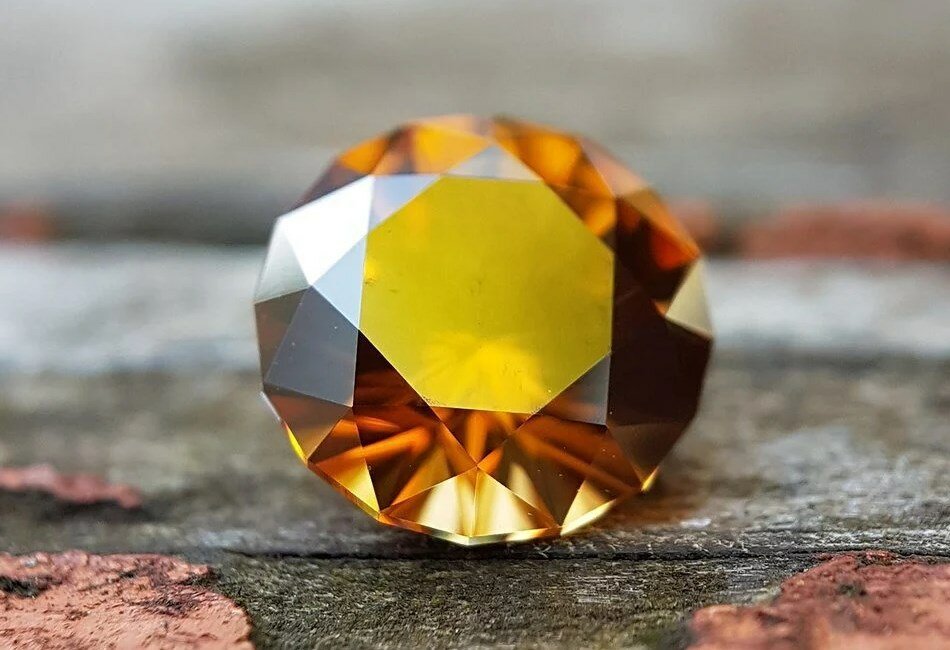- UrbanStems Wedding Bouquet Review - April 30, 2025
- Best Wedding Flowers Online - April 8, 2025
- Zola Review: My Take on Zola in 2025 - March 9, 2025
Orange gemstones might not be the most popular or common for jewelry, but I still remember the pair of citrine drop earrings that made me fall in love with jewelry design. They were on display at a little shop where I used to buy my jewelry-making supplies. I never purchased them, and here I am dreaming about them over a decade later.
Orange gemstones are bold and unique, and they’re a great way to add warmth and joy to any style. In this guide, I’ll walk you through some of my favorite orange gemstones, along with their durability, hardness, other properties, and significant meaning.
Bottom Line Up Front
Orange is a bold and unexpected color for a gemstone, especially when it comes to jewelry. They may not be the most traditional choice, especially for a gemstone engagement ring, but there exists a wide variety of orange-hued gemstones, ranging from the common citrines and ambers to much more rare spessartite garnet and orange diamonds. Read on for some of my favorite orange gemstones, including my favorite for engagement jewelry, the padparadscha sapphire.
Orange Gemstones Guide

The color orange is almost synonymous with energy and cheer. It’s a warm, bright hue often associated with vitality and youth. Orange is frequently linked with happiness, joy, and positivity. It is also used to symbolize courage, creativity, and leadership. Some orange gemstones, such as citrine, are thought to bring good luck and even reverse bad luck. Many orange gemstones are believed to have healing properties and promote not only physical but mental and emotional health as well.
Orange Gems in History
- Queen Victoria was a fan of citrine jewelry and helped to popularize it.
- Citrine was also very popular among several famous actresses during Hollywood’s golden age.
- Princess Eugenie’s engagement ring is a padparadscha sapphire.
- Halle Berry wore the famous Pumpkin Diamond while she accepted the first best actress Oscar given to an African American woman.
Which birthstones are orange?
- Garnet is the birthstone for January, and while garnet is often red, several orange varieties exist.
- Amber is sometimes seen as an alternative birthstone for February.
- Diamond is April’s birthstone, and orange diamonds are some of the rarest in the world.
- Moonstone is an alternative birthstone for June.
- Carnelian is an alternative birthstone for July.
- Spinel is an alternative birthstone for August, and orange spinel is a rare and beautiful option for birthstone jewelry.
- Opal is the birthstone for October, and tourmaline is an alternative. Orange tourmaline is rare and lovely, and Mexican Fire Opal is one of the most stunning orange stones.
- Both topaz and citrine are birthstones for November
What metals can you wear orange gemstones with?
Yellow gold or rose gold complement the warmth of orange gemstones, while white metals, such as white gold and silver provide contrast, making the gemstone pop.
Types of Orange Gemstones – (hardly an exhaustive list, though these are some of my favorites)
Amber

Amber is one of the few “organic gemstones” meaning it isn’t a mineral but is made from organic material (coral, below, is also an organic gemstone.) Amber is made from the hardened resin from prehistoric pine trees and can take several million years to form. It is a soft gem, and it sometimes smells faintly of pine. The most expensive amber contains insect or plant inclusions that were preserved in the resin. Amber jewelry was popular among Ancient Romans, and decorative pieces have been found dating as far back as the Stone Age!
The Baltic countries in particular are known for their amber. A few years ago during a trip to Latvia, I spent a day in Jurmala, a small beach town where amber washes right up on the shore! Buy Here
- Significant Meaning – Amber is seen as an alternative birthstone for February. It is thought to aid with memory loss and heal headaches.
- Color – Golden, yellow, brown, black, red, or even green. Yellow, golden, and honey-colored amber are the most common.
- Cut – Amber is usually polished rather than cut because it is extremely soft and fragile. Polished organic shapes, as well as rounds, ovals, and even hearts, are common.
- Hardness – 2 to 2.5 Mohs
- Durability – Amber can be sensitive to chemicals and alcohol, so extra care is needed, especially when wearing it on a ring. Be wary of your perfume when wearing amber jewelry. Amber will also decompose under high heat, and shouldn’t be put in conditions over 150 degrees Fahrenheit unless you intend to burn it as incense, as some often do!
- Cost – Ranges from extremely affordable to very expensive for larger included pieces. Most pieces of Baltic amber fall between the $1 to $30 per carat range.
Carnelian
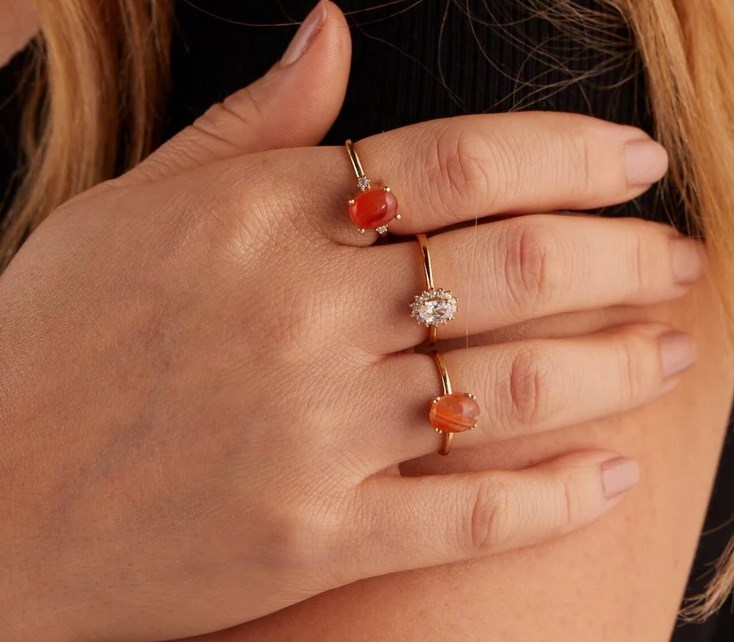
Carnelian is a type of chalcedony that gets its reddish-orange hue from iron oxide. Commonly associated with kings, it was very popular in Ancient Egypt, Greece, and Rome as jewelry and sometimes carved into signet rings. Napoleon had a carnelian which he famously carried into battle with him and subsequently left to his nephew. According to the Islamic religion, the Prophet Muhammad wore a carnelian ring. Buy Here
- Significant Meaning – Carnelian is an alternative birthstone for July and the 17th anniversary stone. It is said to help ward off sickness, symbolize passion and desire, and boost confidence and creativity, the latter of which attributes gave it its nicknames “singers’ stone” and “artists’ stone.” Ancient Egyptians thought it protected the dead on their journey into the afterlife.
- Color – Deep red-orange to yellow-orange. Carnelian is often heat-treated to permanently deepen the color.
- Cut – Carnelian is often used in beads or cut into cabochons.
- Hardness – 6.5 to 7 Mohs
- Durability – The color of carnelian may darken when exposed to heat or even just sunlight.
- Cost – Carnelian is very affordable. Most stones only cost a few dollars per carat.
Citrine
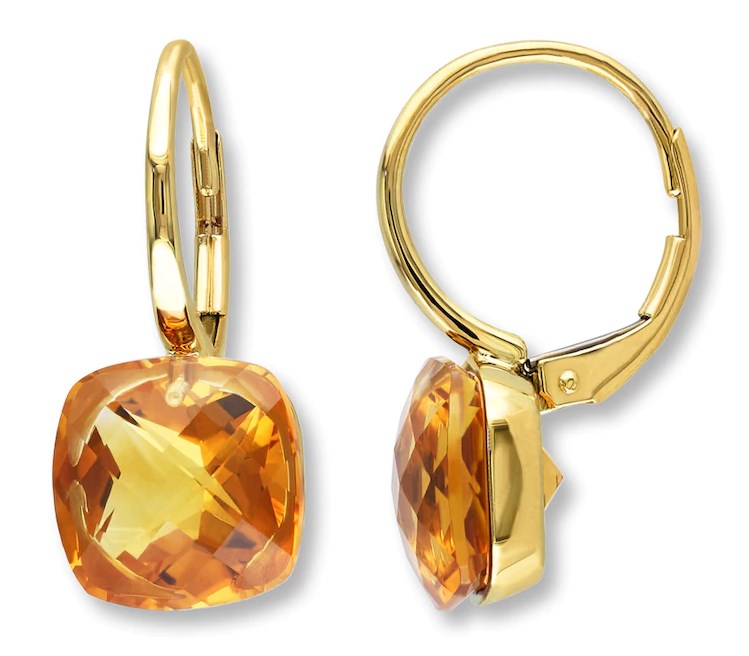
Citrine is a type of transparent quartz that is named after the Latin root for lemon. Natural citrine is relatively rare compared to other quartz, and a lot of citrine on the market is made by heat-treating smoky quartz or amethyst. Citrine was popular among the Ancient Greeks and Romans, who used it for decoration, on the hilts of blades, and as a way to ward off negative energy. Queen Victoria was also particularly fond of citrine. Buy Here
- Significant Meaning – Citrine is one of the birthstones for November, and is the 13th anniversary stone. It is thought to reverse bad luck and bring good luck and fortune. Citrine is also said to promote wellness and energy and is thought to be a healing crystal.
- Color – Citrusy yellows and oranges, deeper ambers, and caramels. Citrine is very transparent and sometimes smoky, and most citrine found on the market is heat-treated in order to enhance its color.
- Cut – Because citrine is readily available in large sizes, there’s no real limit to the types of cuts jewelers can use. Citrine is often faceted in dramatic and interesting ways or carved.
- Hardness – 7 Mohs
- Durability – Some citrine’s color may fade when exposed to high heat
- Cost – Very affordable, generally around $10-30 per carat
Clinohumite
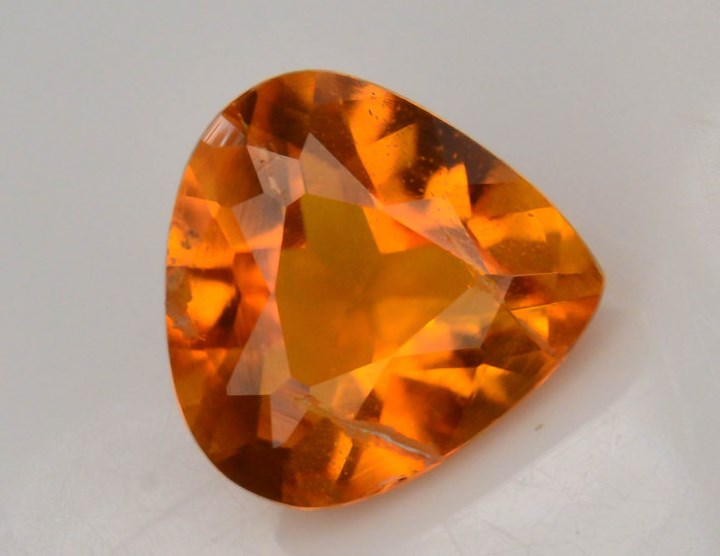
You may have never heard of clinohumite. That’s because it’s so rare that you probably won’t find it in a jewelry store. It’s a favorite among gem collectors, but any jewelry made from clinohumite is probably going to need to be custom designed. The stone was originally found in limestone that erupted from Mount Vesuvius. Buy Here
- Significant Meaning – Clinohumite is said to be energizing and revitalizing and help promote restful sleep.
- Color – orange, yellow, and red ranging from golden to caramel.
- Cut – Common cuts are oval, cushion, round, emerald, or cabochon
- Hardness – 6 Mohs
- Durability – Clinohumite is rather brittle and fractures easily
- Cost – Clinohumite is rare, so gemstones can cost hundreds or even thousands of dollars.
Coral

Another organic gemstone, coral is made from calcium carbonate and formed in the sea from the exoskeleton of coral polyps. Most coral is protected, but you can still find some coral jewelry on the market in the form of recycled, vintage, or even antique pieces. It is illegal to harvest all but the most regulated coral in the United States, and most parts of the world have at least some restrictions on coral harvesting.
Coral has been used in jewelry since before recorded history. It was particularly popular with the Ancient Greeks, Romans, and Native Americans. Buy Here
- Significant Meaning – Coral has been worn since ancient times as protection against evil. Like many other orange stones, coral is also believed to have powerful medicinal properties. It is also said to have the power to stop storms.
- Color – Salmon, orange, pink, white, red, black, or golden
- Cut – Often carved or made into beads
- Hardness – 3.5 to 4 Mohs
- Durability – Coral is heat sensitive and very sensitive to chemicals and acid.
- Cost – Coral is moderately priced, but because it is protected larger and more prized pieces tend to be more expensive. Expect to pay anywhere from a few dollars to a few hundred and beyond per carat.
Hessonite Garnet
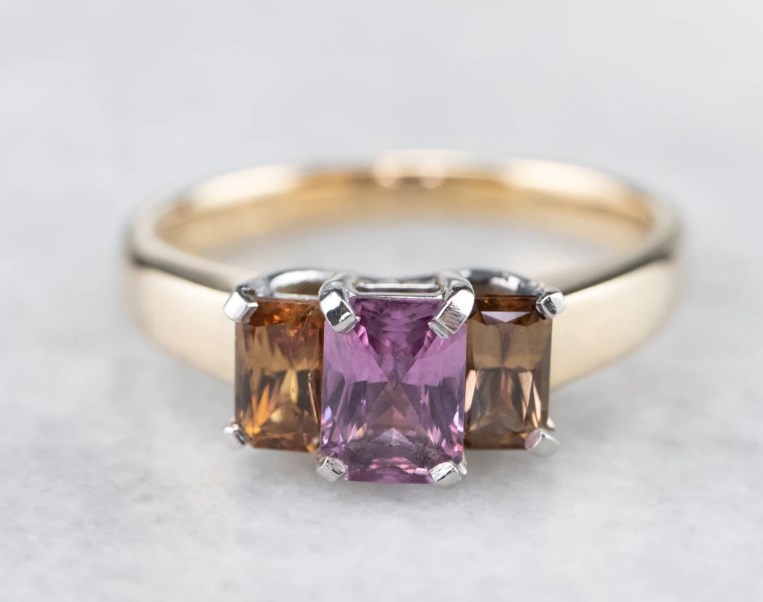
Hessonite garnet is a reddish orange-brown variety of garnet that is a relatively inexpensive option, unlike spessartite garnet (see below.) The name hessonite comes from the Greek word for inferior because the stone is less durable and softer than other types of garnet. Ancient Greeks and Romans carved hessonite into cameos or seals worn on rings. Legend says that Noah used a garnet to illuminate the ark. Hessonite is also one of the stones in the navaratna jewelry popular in South Asian cultures. Buy Here
- Significant Meaning – Garnet is the birthstone for January and the second anniversary stone.
- Color – Deep honey color to orange/brown, occasionally with pinkish tones. Hessonite is sometimes called “cinnamon stone.”
- Cut – Oval and round cuts are common for hessonite. Ancient Greeks and Romans carved images into the stones.
- Hardness – 6.5 to 7 Mohs. Hessonite garnets tend to have a lower hardness than other garnets.
- Durability – Hessonites have some heat sensitivity and should be worn in protective settings.
- Cost – Hessonites are less expensive than some other garnets and tend to fall in the less than $100 per carat range.
Imperial Topaz
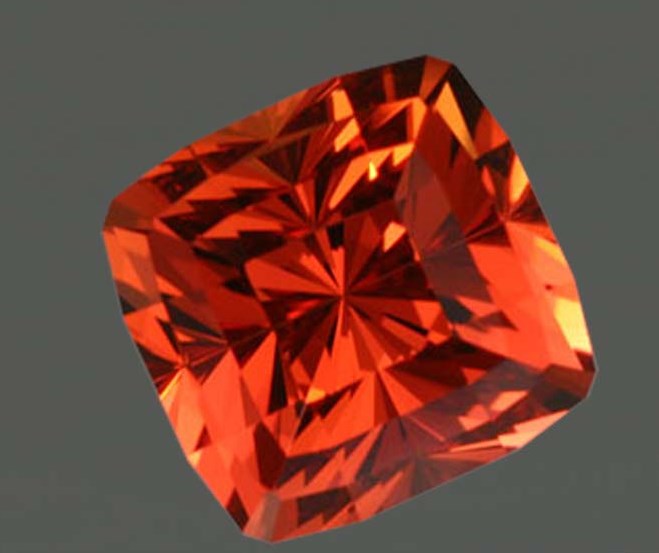
Topaz comes in a variety of colors, but Imperial Topaz is the name given to topaz that is a golden or pinkish orange color. It is considered to be the rarest and most valuable color of topaz. Buy Here
- Significant Meaning – Topaz is one of the birthstones for November, and is the stone associated with both the fourth and nineteenth anniversaries. It is believed to bring good fortune, and is often used to represent love. It is also believed to promote both fidelity and creativity.
- Color – Golden to pinkish orange, peach
- Cut – Elongated cuts, such as emerald, oval, or pear are typically favored, but topaz can be cut and faceted in a variety of ways.
- Hardness – 8 Mohs
- Durability – Because of its perfect cleavage, topaz can be prone to splitting if not set or cleaned properly. A protective setting can help reduce the chance of damage.
- Cost – Imperial topaz can be up to $1000 or even several thousand per carat for larger stones
Mexican Fire Opal
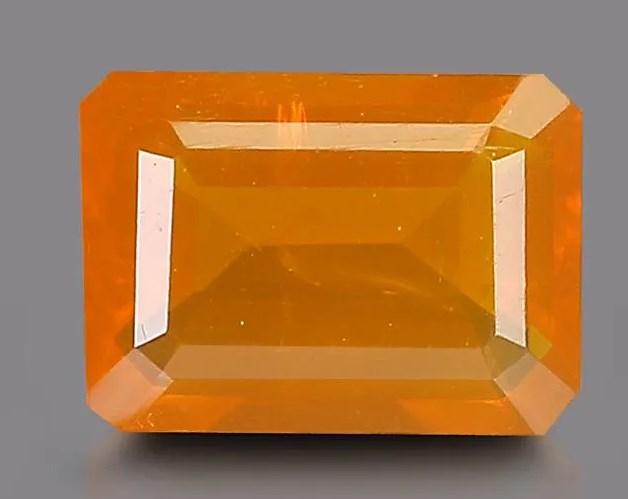
Mexican fire opal (also known as simply Mexican opal or fire opal) is rarer than traditional opal. Unlike traditional and precious opal, Mexican fire opal is transparent to translucent and reddish-orange in color. Despite its name, it doesn’t display the same “fire” or play of color that precious opal is known for.
It has been found in volcanoes in Mexico and around the world, and some fire opals have been found in Aztec burial sites dating back to at least 850 AD. Buy Here
- Significant Meaning – Opal is the October birthstone and the 14th anniversary gemstone. It is thought to bring joy, good fortune, and success, as well as boost confidence. Opal is also said to heal back and kidney problems. It is assigned to Neptune, Pluto and the heart chakra.
- Color – Mexican fire opal isn’t pastel like precious opal, nor does it display the same play of colors that is so highly valued in precious opal. Mexican fire opal is named after its body color, and tends to be fiery orange, or orange-red.
- Cut – Mexican fire opal is naturally faceted and translucent or transparent, so in jewelry it is often cut faceted, unlike most precious opal.
- Hardness – 5.5 to 6.5 Mohs
- Durability – As with all opals, fire opals are prone to cracking, especially if they dry out. They are also very heat sensitive.
- Cost – Up to $10,000 per carat, with most fire opals falling in the $5 to $300 per carat range.
Moonstone

Although the most prized moonstones are an iridescent blue color, orange moonstones are not uncommon and are just as lovely. Buy Here
- Significant Meaning – Moonstone is an alternative June birthstone.
- Color – Orange, peach, yellow, brown, white, or blue. Some moonstones are almost transparent.
- Cut – Moonstones are usually polished or cut into cabochons, but some transparent stones are occasionally faceted.
- Hardness – 6 to 6.5 Mohs
- Durability – Moonstones have perfect cleavage and fracture easily. They should be worn with care.
- Cost – Expect to pay between $10 and $1000 for a jewelry grade moonstone.
Orange Diamond
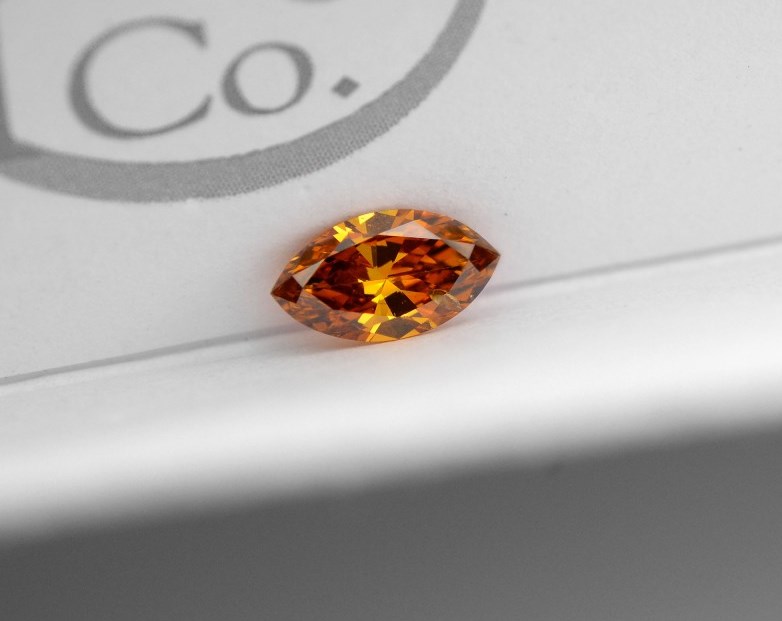
Orange diamonds are an extremely rare variety of fancy diamonds, making up less than 1% of all diamonds. They are created due to the presence of nitrogen during the stones’ formation. Also known as “fire diamonds” or “pumpkins,” natural orange diamonds come with a hefty price tag, though synthetic options are available. The world’s largest orange diamond, known simply as “The Orange,” sold for $31.5 million at auction back in 2013, and actress Halle Berry wore another famous orange diamond, “The Pumpkin,” while accepting her Oscar for Best Actress in 2002. Buy Here
- Significant Meaning – Diamond is the birthstone for April, and the stone for both the 60th and 75th anniversaries. Often used to represent love and strength, diamonds have become ubiquitous with engagement jewelry.
- Color – Light to deep hues of orange, pink, brown, or peach. Diamonds rated fancy vivid orange and fancy deep orange (by the GIA) are the most expensive.
- Cut – Orange diamonds are faceted in all the classic cuts. Many are cut to preserve weight since orange diamonds are so rare.
- Hardness – 10 Mohs.
- Durability – Orange diamonds are just as durable as any other color diamond, making them suitable for everyday wear.
- Cost – Natural orange diamonds are extremely expensive and can cost several thousand dollars, and upwards of one million, per carat. Synthetic orange diamonds are more affordable.
Orange Spinel
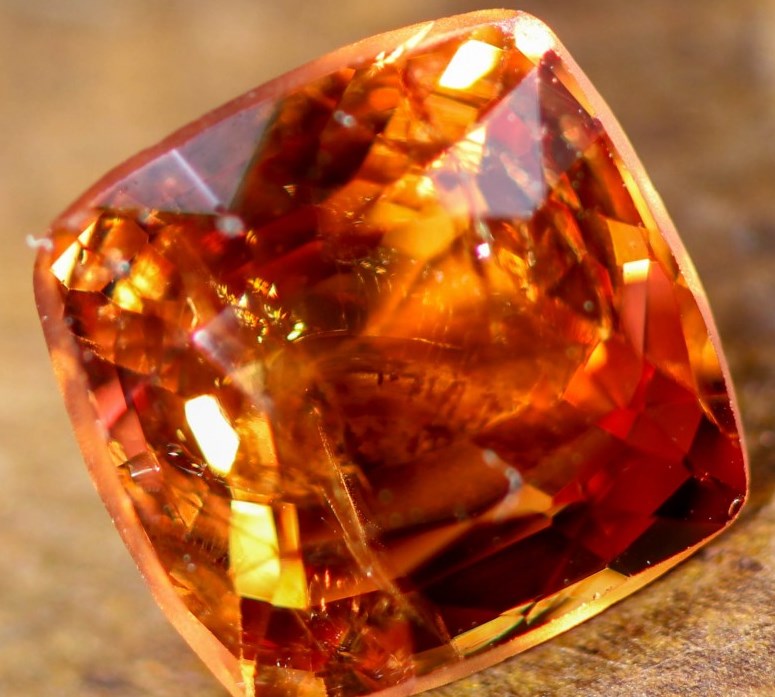
A rare shade of spinel, orange spinel is not quite as valuable as red or pink spinel. Spinel is an extremely brilliant stone that rivals even a diamond. Buy Here
- Significant Meaning – Spinel is an alternate birthstone for August.
- Color – Bright “flame-orange,” or deeper red-orange. Some spinnels display an asterism which give them a starburst look due to their inclusions.
- Cut – Faceted cuts are very popular, especially round and cushion cuts. Sometimes spinels are cut in non-standard sizes and shapes to retain weight.
- Hardness – 8 Mohs
- Durability – The color of a spinel can fade due to prolonged exposure to heat.
- Cost – Orange spinels can cost several thousand dollars a carat.
Orange Tourmaline

Orange is not a very common shade of tourmaline, but orange tourmaline does exist and is thought to balance emotions, purify the body, and promote spiritual growth. Buy Here
- Significant Meaning – Tourmaline is an alternative October birthstone. It is believed to have the power of reconciliation and heal relationships and friendships and to help heal broken hearts. It is also believed to aid in sleep, and help people achieve enlightenment.
- Color – Tourmaline often displays two colors at once when viewed from different angles, a property known as pleochroism. Orange tourmalines tend to have pink or brown tints to them, and heat treatment is common to enhance their color.
- Cut – Tourmaline is usually faceted to showcase its brilliance.
- Hardness – 7 to 7.5 Mohs
- Durability – Tourmalines with inclusions or with multiple colors can be a challenge to cut and can be prone to fracture, but once they’re set they’re a fairly durable gemstone. They are, however, prone to collect dust due to their conductivity.
- Cost – Orange tourmalines average around $300 to $600 per carat.
Orange Zircon
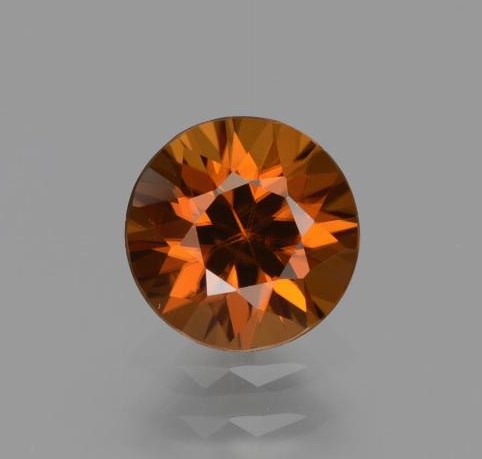
Not to be confused with cubic zirconia, zircon is a natural mineral (in fact, it’s one of the oldest known minerals on Earth.) It’s extremely brilliant and very clear, making it a good substitute for diamonds in jewelry. Zircon can be found in a rainbow of colors, and orange zircons have been referenced in history and in the bible as “hyacinths” or “jacinths.” Buy Here
- Significant Meaning – Another healing stone, zircon is also believed to protect travelers. It was used as a sleep aid in the middle ages.
- Color – Orange zircons range from yellow-orange to red-orange and caramel/whiskey colors.
- Cut – Zircon is usually faceted to showcase its brilliance and help avoid chipping.
- Hardness – 6 to 7.5 Mohs
- Durability – Zircon can chip easily and is generally cut and set in such a way to avoid wear to the edges.
- Cost – Orange zircon averages around $50 to $400 per carat.
Padparadscha Sapphire
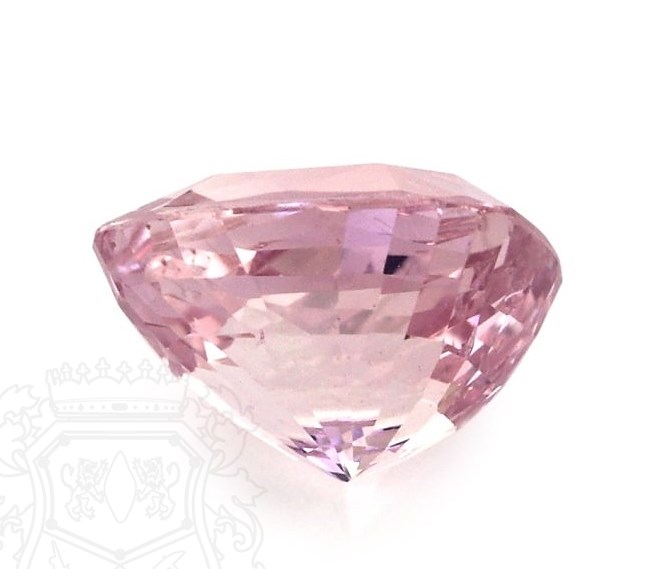
A member of the corundum family, padparadscha is the rarest and most valuable of all sapphires. Sapphires are found naturally in every color except red, since a red corundum is a ruby! While orange sapphires in other hues exist (and are simply referred to as orange sapphires,) padparadscha sapphires are a specific pinkish-orange color, reminiscent of a lotus flower (the Sanskrit word for which gave padparadscha its name.)
Sapphires are very durable and are often seen to represent strength and love. For those reasons, sapphires were actually the preferred stone for engagement rings before diamonds took the lead in popularity. Princess Eugenie famously sports a padparadscha sapphire engagement ring. Buy Here
- Significant Meaning – Sapphire (though traditionally blue sapphire) is September’s birthstone. They are believed to be healing stones and are used to treat blood disorders. They are also used to represent strength and love, and orange sapphire in particular is used to represent wisdom.
- Color – Color is the most important feature of padparadscha sapphires, especially when it comes to determining their price. Padparadscha sapphires are defined by their pinkish-orange salmon color, which is said to be the color of a lotus flower mixed with a sunset.
- Cut – Padparadscha is often cut to conserve weight since it’s extremely rare. Cushion and oval cuts are more common than round or emerald. It is sometimes, but rarely, made into cabochons if it can’t be faceted. Padparadscha is sometimes cut asymmetrically to conserve as much weight as possible.
- Hardness – 9 Mohs
- Durability – Padparadscha sapphires are durable enough for everyday wear, making them a great choice for engagement rings.
- Cost – Padparadsha have a high cost compared to other fancy sapphires and can run in the hundreds or thousands of dollars per carat, with the most expensive stones costing as much as $30,000 per carat.
Spessartite Garnet
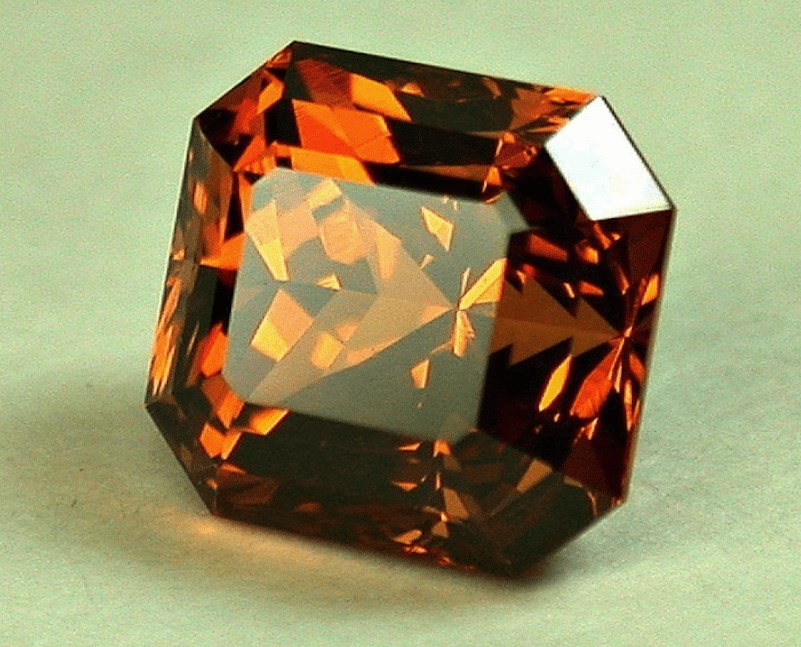
Another orange garnet, spessartite (or spessartine) tends to be more expensive than hessonite garnet and is brighter orange or more red-orange than the brown-tinged hessonite. The brightest orange spessartite, known as mandarin spessartite or simply just mandarin garnet, is the most sought after. Spessartite garnets are a great choice for orange engagement rings since their hardness makes them a good choice for everyday wear. Buy Here
- Significant Meaning – Garnet is the January birthstone
- Color – Bright orange to deep reddish-orange. Mandarin Spessartite is the most pure orange garnet and therefore the most valuable.
- Cut – Because it has no cleavage, spessartite can be cut in any number of ways, faceted or cabochon. Facets are cut in a way to emphasize the stone’s brilliance.
- Hardness – 7 to 7.5 Mohs
- Durability – Since spessartite is relatively hard and has no cleavage, it’s durable enough for everyday wear.
- Cost – Spessartite garnets can range from several hundred to over a thousand dollars per carat.
Sunstone (also Oregon Sunstone)
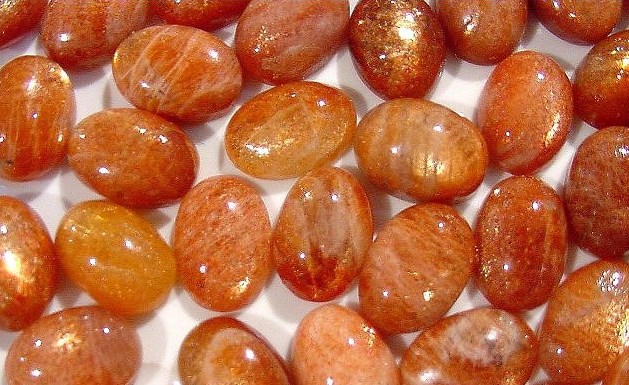
Sunstone got its name from its inclusions, which cause a glowing effect below the surface of the stone. Oregon sunstone is a particularly popular type of sunstone, found in the region for which it’s named, that contains copper inclusions. Buy Here
- Significant Meaning – In birthstone mythology, sunstone is the birthstone for people born on Sunday. It is said to have healing and antidepressant properties. In some lore, sunstones represent freedom.
- Color – Orange, red, pink, peach, or brown. Some appear glittery due to their inclusions.
- Cut – Sunstone fractures easily and needs a protective setting. They are commonly cut into cabochons, but Oregon sunstone can be faceted.
- Hardness – 6 to 6.5 Mohs
- Durability – Sunstone fractures easily and has perfect cleavage. Care should be taken.
- Cost – Inexpensive, ranging from a few dollars up to around $50 per carat. Very large stones in rare colors may be upwards of a thousand dollars per carat.
A Word to the Wise
Ask for a certificate of authenticity when buying precious orange gemstones such as diamonds or sapphires. They are extremely rare and hard to find in stores. Be wary of scams – anything that seems too good to be true probably is.
Honorable Mention
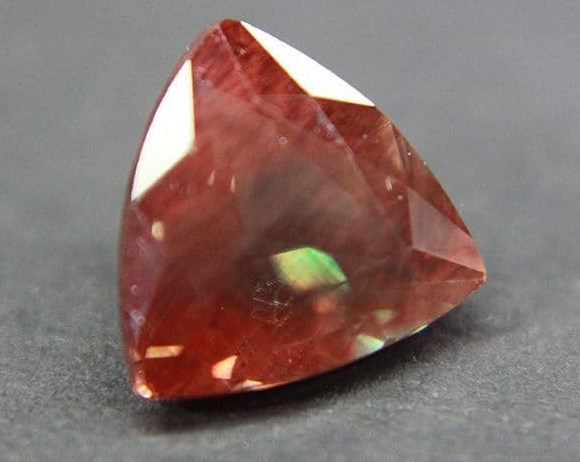
- Andesine – A color-enhanced version of labradorite.
- Morganite – A soft pinkish-orange or pink stone often used as a substitute for a diamond in engagement jewelry.
- Orange Aventurine – An opaque, glittery type of quartz. Most aventurine is green, but orange aventurine does exist.
- Orange Agate – A gorgeously banded orange stone.
- Orange Moissanite – A stone literally made from space dust, moissanite is another common engagement ring gem.
- Sphalerite – An extremely rare gem with greater fire than a diamond, not generally used in jewelry because it’s very soft.
Pros & Cons of Orange Gemstones
Pros
- Orange gemstones are very unique.
- There are several options for orange gemstones that are durable enough for regular or daily wear as jewelry.
- Orange gemstones add joy, warmth, and energy to any style.
Cons
- Many orange gemstones are expensive
- Many orange gemstones are heat treated to enhance their color. This could make them less desirable for some people.
- Because some orange gemstones are so rare, they come with a risk of scam. Make sure to ask for a certificate of authenticity when purchasing an expensive orange gemstone.
FAQ
Answer: Imperial topaz, orange diamonds, and padparadscha sapphires are among the most expensive orange gemstones.
Answer: Every type of gemstone is different, and should be cleaned in accordance with their specific needs. That being said, a soft polishing cloth or gentle soap and water works well for most stones. Many orange gemstones are heat sensitive, so extra care should be taken.
Answer: Orange gemstones symbolize youth, vitality, happiness, and creativity. Many orange gemstones were traditionally thought to have healing benefits and bring luck and joy.
Answer: Some orange gemstones, such as citrine, carnelian, and amber can be very affordable, while others, like orange diamonds or imperial topaz are among the most valuable gemstones in the world.
Answer: Padparadscha sapphires are the most expensive orange sapphires.
Answer: There are no orange rubies because both rubies and sapphires are corundum, and any corundum that is not red is a sapphire. An “orange ruby” would actually be an orange sapphire.
Answer: Spessartite garnets, padparadscha or other orange sapphires, and orange diamonds (if they’re within your budget) are all great choices for orange engagement rings. They’re all beautiful gemstones and durable enough for everyday wear.
Answer: Both citrine and carnelian are beautiful, affordable orange gemstones. Because they aren’t as hard as other gems, jewelry made from citrine or carnelian should be worn with care.
Final Thoughts
While they may not be the most popular for jewelry or the most common, there are many types of orange gemstones that range in color from light citrusy yellow-oranges to deep caramel and rust tones. Some of them, such as carnelian, citrine, and amber, are very affordable, while others, like padparadscha sapphire and spessartite garnet are great options for engagement rings or everyday wear. Orange gemstone jewelry is a great way to infuse your day with energy and joy, and maybe bring a little creativity or healing power into your life.
Looking for more interesting readings? Check out:
